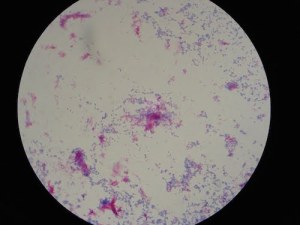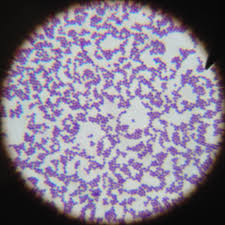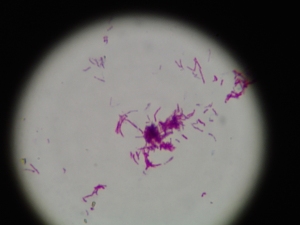Background
The purpose of this experiment is to illustrate the differentiation of bacteria in acid-fast and non-acid fast staining groups. Most bacterial organisms can be stained by either simple or Gram staining procedures. The characteristics displayed between mycobacteria and other microorganisms are very different because of the presence of a thick, waxy wall that makes the stain penetration very difficult. Once the stain is penetrated, it is not able to be readily removed even with the vigorous acid-alcohol agent, unlike the 95% ethyl alcohol that is used in gram staining. This a very important property because it is what distinguishes these organisms as acid-fast, versus non- acid-fast, which are easily decolorized by acid alcohol (Cappuccino 81).
The acid-fast staining uses three different reagents which includes the primary stain, the decolorizing agent, and the counterstain. The primary stain being used is carbolfuchsin which is a dark red stain 5% phenol that is soluble in the lipoidal materials. It penetrates most of the cell wall, is retained, and enters the bacteria. Acid-alcohol is used as the decolorizing agent, because acid-fast cells will be resistant to decolorization due to the fact that the primary stain is more soluble in the cellular waxes than in the decolorizing agent. The final reagent used in this process is methylene blue, which is used to stain previously decolorized cells, and serves as the counterstain.
Materials and Methods
In completing this experiment, we used a Bunsen burner, hot plate, 250 ml beaker, inoculating loop, glass slides, bibulous paper, lens paper, staining tray, and a microscope. We also used 72-96 hour soy broth culture of M. smegmatis and 18-24 hour culture of S. aureus and for our reagents, carbolfuschin, acid-alcohol, and methylene blue. In our smear preparation, we took three glass slides and using aseptic technique, we prepared a bacterial smear of each organism plus a third smear which was a mixture of the two onto the third slide. We then allowed the smears to dry, and once they we dry we heat fixed them by quickly running then over the flame of the Bunsen burner.
After the smears were completely dry and heat fixed, we flooded the smears with carbolfuchsin and placed the slide over a beaker on a warm hot plate, and allowed it to steam for 5 minutes. Once the slides were completely cooled, we washed them with tap water. Next, we decolorized them by adding the acid alcohol, drop by drop onto the slides until the alcohol was almost clear with a red tinge, then washed it with tap water again. Then we counterstained with methylene blue for two minutes and washed with tap water. Once that part was done, we blotted the slides with bibulous paper and examined it using the microscope under oil immersion.
Results
The acid-fast stain revealed that S. aureus stained blue, which meant that it was non acid-fast. S. aureus was circular-shaped and had a clustered (almost like grapes) arrangement. Antithetically, M. smegmatis stained red, which meant that it was acid fast. M. smegmatis was irregular-shaped and had a pseudofilamentous arrangement. The mixed culture of S. aureus and M. smegmatis stained pink and blue.

Mixture of M. smegmatis and S. aureus
Review Questions:
1. Why must heat or a surface-active agent be used with application of the primary stain during acid-fast staining?
Heat is used in acid-fast staining to drive the carbolfuchsin lipoidal cell wall and into the cytoplasm. Alternatively, a surface-active agent can be used to reduce the surface tension between cell wall of the bacteria and the stain.
2. What is the specific diagnostic value of this staining procedure?
A specific diagnostic value of acid-fast staining is its use to confirm the presence of Mycobacterium tuberculosis is patients suspected of suffering from pulmonary tuberculosis.
3. Why is the application of heat or a surface-active agent not required during the application of the counterstain in acid-fast staining?
The counter stain is used to colorize the non-acid-fast cells present in the specimen. These cells do not have the type of cell wall that requires heat application for the stain to penetrate.
4. A child presents symptoms suggestive of tuberculosis, namely a respiratory infection with a productive cough. Microscopic examination of the child’s sputum reveals no acid-fast rods. However, examination of gastric washings reveals the presence of both acid-fast and non-acid fast bacilli. Do you think the child has active tuberculosis? Explain.
It does not appear likely that the child has active tuberculosis since the sputum test is a reliable means of diagnosis pulmonary tuberculosis. It is recommended that three specimens of sputum be collected from suspect individuals and analyzed (duhscme.com)
Works Cited
Cappuccino, James G. Microbiology: a laboratory manual – 10th ed. Glenview, IL: Pearson, 2014. Print.
Duhscme.com. “Tuberculosis.” duhscme.com. Ojha Institute of Chest Diseases, 2011. Web. 5 April 2014.
Last updated on 8-April-2014 6:23 AM

